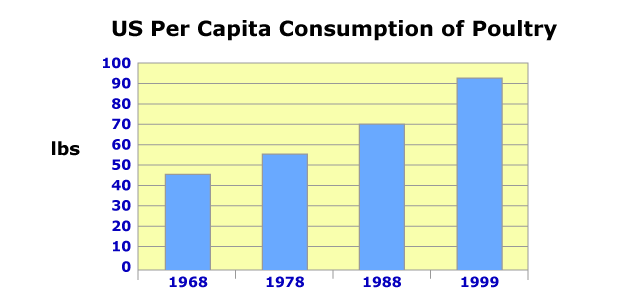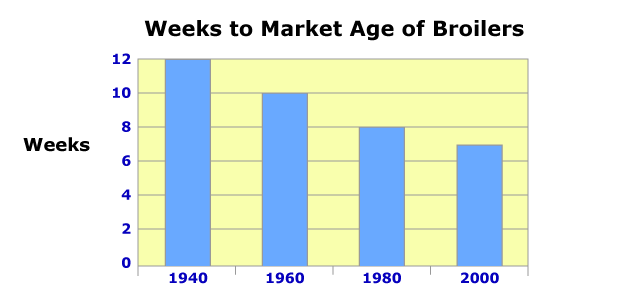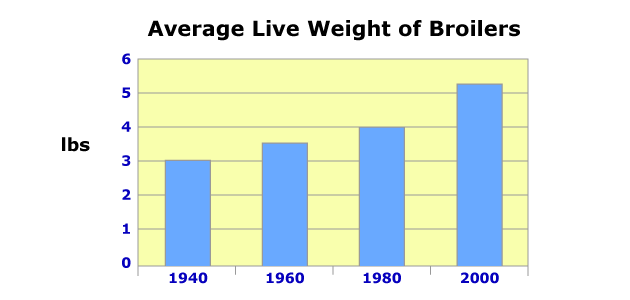Previous Page | Right click this page to print.
Broilers
Now, I am going to talk about broiler feeding. When we talk about broilers, our objectives are different, it’s not like layer birds. Our objective is to produce lean meat as cheaply as possible. We have to be aiming at maximum growth rate. We are looking at maximum economic efficiency. We are looking at maximum yield.
If you look at the per capita consumption of poultry, broilers, we can see a steady increase in poultry consumption.
 The reason of this steady increase in
poultry consumption is, number one, we can buy poultry meat at a cheap
price compared to other meat. Along with several other reasons, consumption
of poultry is raising, is surpassing red meat consumption. And also, the
time it takes for broilers to reach the market age, as you can see from
this graph, is coming down.
The reason of this steady increase in
poultry consumption is, number one, we can buy poultry meat at a cheap
price compared to other meat. Along with several other reasons, consumption
of poultry is raising, is surpassing red meat consumption. And also, the
time it takes for broilers to reach the market age, as you can see from
this graph, is coming down.
 It used to take 12 weeks to produce broilers
in 1940 versus 6 weeks in year 2000. Proper management, proper nutrition,
proper genetic selection has all lead to the decline in the time that
is needed to produce broiler birds. Similarly, feed conversion efficiency,
pound of gain per pound of feed, is also coming down drastically.
It used to take 12 weeks to produce broilers
in 1940 versus 6 weeks in year 2000. Proper management, proper nutrition,
proper genetic selection has all lead to the decline in the time that
is needed to produce broiler birds. Similarly, feed conversion efficiency,
pound of gain per pound of feed, is also coming down drastically.
 Due to all these factors, consumers can
enjoy poultry meat at a very lower cost compared with other meat. Average
live weight of broilers, increasing every year.
Due to all these factors, consumers can
enjoy poultry meat at a very lower cost compared with other meat. Average
live weight of broilers, increasing every year.

When we feed broilers, usually, broilers are given unlimited access. Maximizing the nutrient intake is not always efficient. Different rate, different patterns of growth are being tried by nutritionists to reduce growth in early life by restricting the feed intake slightly, so that when the birds are re-fed or increase the feed at a later stage, they compensate for that weight gain, increasing the efficiency during later stage of production. Some of the studies have shown that by minimizing or restricting feed during early growth can minimize certain metabolic diseases like sudden death. Broiler feeding. Broilers are fed for three different market weights. Number one, Cornish, 1-1.1 kg live weight at 28 days of age. Broiler birds, 1.7-2.5 kg live weight and usually sold at 39-42 days of age. Roaster birds, 3.3-4 kg, usually sold 50-60 days of age.
Broiler feeding. Starter diets, usually fed as crumbled for 0-3 weeks.
At this stage, there is a rapid growth or rapid muscle accretion. To meet
that need, very high crude protein is included and high metabolizable
energy, 20-23% crude protein is fed at this stage and metabolizable energy
of 3,050 ME kilocalories per kilogram. Usually, newly hatched chick, broiler
chick, weighing 45 grams, in 3 weeks time it reaches 700 grams and much
of it is protein. There is high muscle accretion. Muscle is basically
protein. We feed a high protein diet. Grower diet could be pellet or crumble,
usually fed from 3-6 weeks of age. At this stage, we cut down the crude
protein to 20% and also we cut down, we make the energy anywhere from
3,150-3,200 ME kilocalories per kilogram. Broiler finisher diet. As the
bird grows, we cut down again the protein to 18% crude protein and we
still keep the energy at 3,200. Again, pellet or crumble feeds are fed.
Usually, broiler finisher diets are fed last six days before slaughter.
We decreased the nutrient density. At this stage, there is less muscle
accretion, less protein is deposited, so we cut down the protein. Roaster
diets, 42 days to slaughter. Again, coming down in crude protein to 16%
crude protein and 3,200 kilocalories per kilogram.
Previous Page | Right click this page to print.